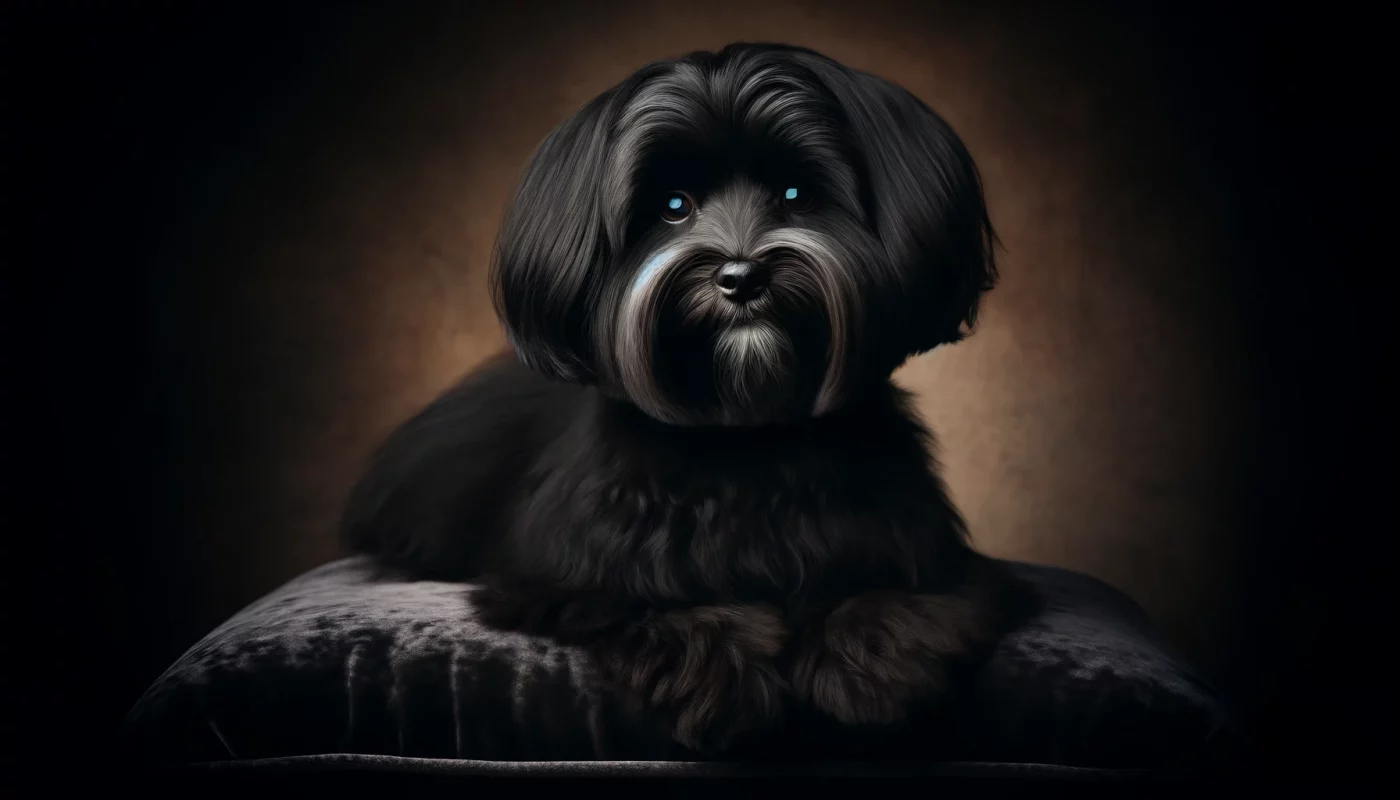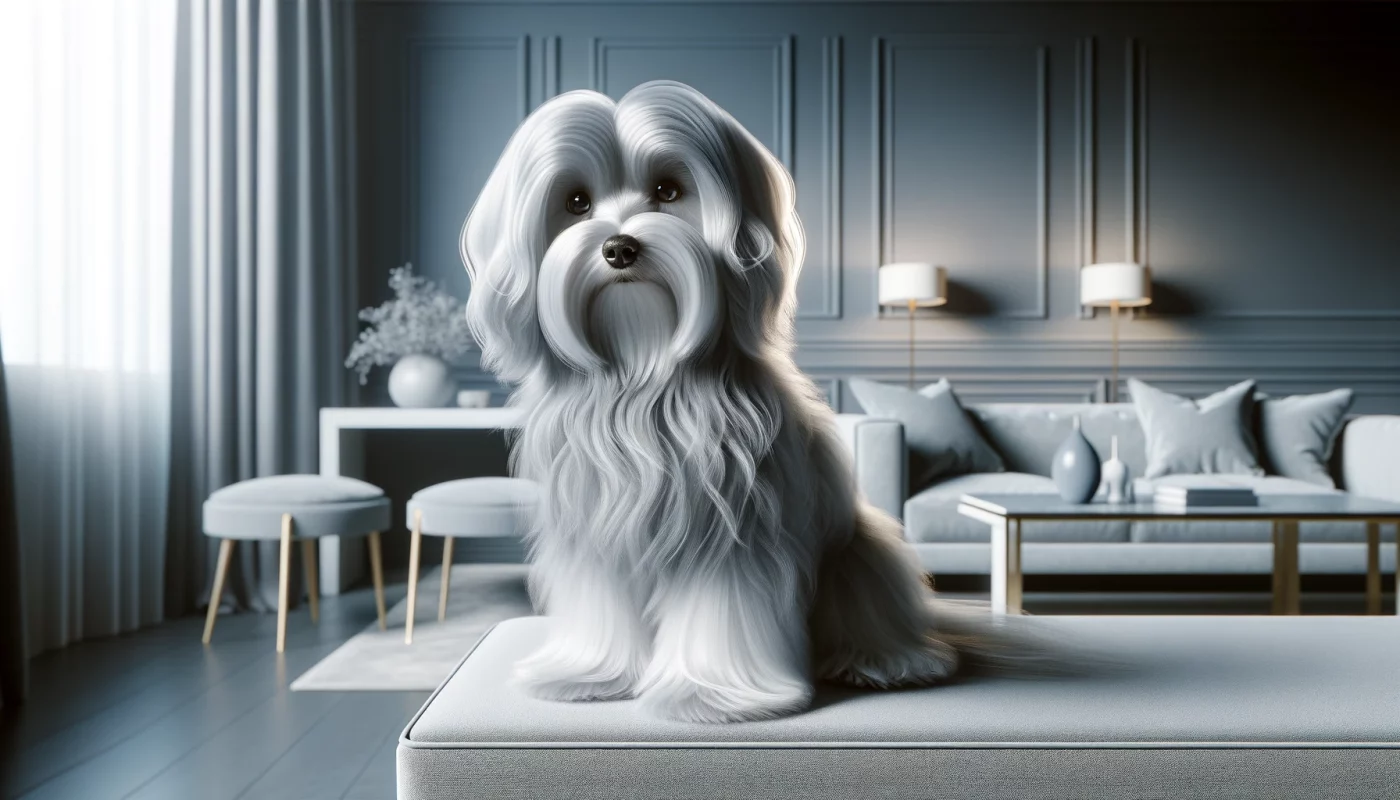The Havanese, a breed celebrated for its exuberant personality and striking appearance, displays a captivating array of coat colors that add to its charm. Originating from Cuba, these small yet sturdy dogs have become beloved companions around the world, not only for their sociable nature but also for their diverse color palette. This palette ranges from deep, rich colors to light, pastel shades, allowing them to stand out in any crowd. Each color variation not only enhances the Havanese’s aesthetic appeal but also showcases the breed’s unique genetic heritage. This article explores seven stunning color variations of the Havanese, providing insights into how these colors complement their playful demeanor and luxurious coats.
1. Black

Black Havanese possess a sleek, glossy coat that exudes elegance and sophistication. The depth of the black color in their fur can vary from a jet black to a softer charcoal, each strand shimmering under the light. This color is particularly striking against the Havanese’s expressive, almond-shaped eyes, making their cheerful expressions even more pronounced. Black Havanese are often admired for their dramatic look, which contrasts beautifully with their light-hearted and affectionate personalities.
2. Chocolate

The Chocolate Havanese features a warm, rich brown color that makes it look almost edible. This delightful shade ranges from a dark, almost black chocolate to a lighter, milky cocoa, providing a soft yet captivating appearance. Chocolate Havanese are rare and considered very special due to the genetic makeup required to achieve this coat color. The warm undertones of their fur complement the sunny disposition of the breed, making them a favorite among those who appreciate both rarity and beauty.
3. Cream

Cream Havanese have a soft, almost white coat with just a hint of buttery yellow, giving them a serene and gentle appearance. This light color highlights the silky texture of their long, flowing coat, which requires regular grooming to maintain its splendid condition. The cream color is perfect for showcasing the Havanese’s playful antics, as it provides a beautiful backdrop for their lively expressions and spirited movements.
4. Gold

Gold Havanese sparkle with a vibrant, sunny hue that reflects their cheerful and outgoing personality. This color can range from a pale, soft gold to a more pronounced, rich golden tone, each variation radiant and eye-catching. Gold Havanese are like little rays of sunshine, brightening up every room they enter with their exuberance and stunning coat.
5. Silver

Silver Havanese are a glamorous and somewhat mystical variation of the breed. Their coat color can range from a pale, silvery grey to a deeper, pewter shade. This color is particularly striking as it often changes over the dog’s lifetime, with puppies born black and gradually lightening to silver as they mature. The transformative nature of the silver Havanese’s coat adds an element of surprise and delight to their ownership.
6. Parti-Color

Parti-color Havanese are characterized by having two or more distinct colors in their coat. This can include combinations like black and white, brown and white, or any other color paired with white. These dogs often have charming, irregular patterns that make each one unique. Parti-color Havanese are particularly popular in the show ring due to their distinctive and appealing appearance, which highlights the playful variety within the breed.
7. White

Pure white Havanese are striking in their simplicity, featuring a brilliant, snowy coat that shines against their dark, curious eyes. This color is highly prized for its classic elegance and can make a Havanese look like a small, animated plush toy. White Havanese are not only beautiful but also incredibly photogenic, often appearing to glow from within.
In conclusion, the Havanese breed offers a remarkable spectrum of coat colors, each adding its own flavor and charm to this already delightful breed. From the deep richness of the chocolate to the bright vibrancy of the gold, each color variation of the Havanese enhances its appeal and reflects different aspects of its joyful and affectionate nature. Whether you prefer the elegance of a black or the cheerfulness of a parti-color, there is a Havanese color that is sure to captivate and charm its way into your heart.
Frequently Asked Questions About Havanese Colors
1. What are the most common colors for Havanese dogs?
The most common colors for Havanese dogs include black, white, cream, and gold. These colors cover a broad spectrum, from deep, rich blacks to vibrant, sunny golds. Each color can vary in shade and intensity, providing a wide range of options for potential owners. The variety in color among Havanese dogs adds to their appeal, as they can suit different personal preferences and aesthetics.
2. Can Havanese dogs be multi-colored?
Yes, Havanese dogs can indeed be multi-colored. One of the most popular multi-colored variations is the parti-color, which includes any dog that has white and any other color distributed in patches across the body. Another common pattern is the brindle, where several colors blend together in a striped pattern. These multi-colored coats are highly valued for their uniqueness and beauty.
3. What is a chocolate Havanese?
A chocolate Havanese has a rich, deep brown coat that comes from a specific genetic variation. This color is less common than black or white and is highly sought after due to its striking appearance. Chocolate Havanese may also have lighter brown or amber-colored eyes, which is a rare trait in dogs. The warm, inviting hue of their coat matches their friendly and affectionate personality.
4. Are there any rare colors for Havanese?
Yes, some rare colors for Havanese include pure white and true silver. Silver Havanese are particularly rare because their coat color changes from a darker shade when they are puppies to a luminous silver as they age, due to the progressive graying gene. Pure white Havanese are also uncommon and are prized for their striking, pristine appearance.
5. How does the coat color of a Havanese affect its grooming needs?
Coat color in Havanese does not typically affect the grooming needs of the breed. All Havanese, regardless of color, have a double coat that requires regular grooming to prevent matting and tangling. However, lighter colors such as white or cream may show dirt more readily and may require more frequent bathing to maintain a clean and vibrant coat.
6. Do Havanese puppies change color as they grow?
Yes, Havanese puppies can change color as they mature. This is most noticeable in dogs with the silver gene, where puppies born black or dark gray gradually lighten over several months to years. Additionally, puppies that appear to be one color may develop additional colors or patterns as their adult coat comes in.
7. What determines the coat color of a Havanese?
The coat color of a Havanese is determined by genetics. The combination of genes inherited from both parents influences the puppy’s coat color and pattern. These genes determine not only the color but also the distribution of colors and patterns such as parti-color or brindle.
8. Can Havanese have a brindle coat pattern?
Yes, Havanese can have a brindle coat pattern, although it is not as common as solid colors or parti-colors. Brindle in Havanese consists of a mixture of dark and light stripes, giving them a somewhat tiger-striped appearance. This pattern is due to a specific genetic trait that affects the distribution of pigment in the coat.
9. Are certain Havanese colors associated with specific health issues?
No, there is no evidence to suggest that certain Havanese colors are associated with specific health issues. Health problems in Havanese are generally not linked to coat color. It’s important for potential owners to focus on overall health and genetic testing rather than color when selecting a puppy.
10. Can environmental factors influence the color of a Havanese’s coat?
Environmental factors such as sun exposure can influence the color of a Havanese’s coat to some extent, particularly for those with lighter colors like cream or gold. Sunlight can cause the coat to lighten or bleach, which is often temporary and reversible. However, the primary determinant of a Havanese’s coat color is genetics, not environmental factors.
 Toledo, United States.
Toledo, United States.